If you’re on the hunt for the best acoustic guitar strings, you’ve landed in the right place. Whether you’re a seasoned player seeking a tonal shift, or a beginner navigating the world of acoustic guitars, choosing the right strings is crucial. I’ve spent over two decades exploring the nuances of guitar playing, from travel-sized acoustics to rich-sounding classical guitars. Let me share my expertise to guide you in selecting the ideal strings for your acoustic instrument.
String choice is a deeply personal aspect of guitar playing, and for me, gauge is paramount. While subtle differences may exist between brands, the gauge of your strings fundamentally shapes your guitar’s playability and sound. Experimenting with different brands can offer slight variations, but altering the gauge will dramatically impact your instrument’s voice and feel. For a deeper dive into string gauge and its effects, be sure to check out the FAQs section later in this article.
Another key consideration is whether to opt for coated or uncoated strings. These two types offer distinct sonic and tactile experiences. To my ears, coated strings possess a slightly mellower tone compared to their uncoated counterparts. However, for live performances and frequent playing, the longevity of coated strings is invaluable. Conversely, for intimate home practice or critical recording sessions, I lean towards uncoated strings where pristine sound quality is the top priority.
Deciding on the perfect string can feel overwhelming, leading many players to stick with familiar choices. However, I wholeheartedly encourage you to venture beyond your comfort zone and experiment with different string types and gauges on all your acoustic guitars. This exploration can unlock new sonic possibilities and revitalize your playing, especially if you’re feeling creatively stagnant. Below, I’ve curated six of the best acoustic guitar strings currently available, each tailored to excel in different scenarios. Let’s explore these top picks to help you find your perfect match.
Best Acoustic Guitar Strings: Product Guide
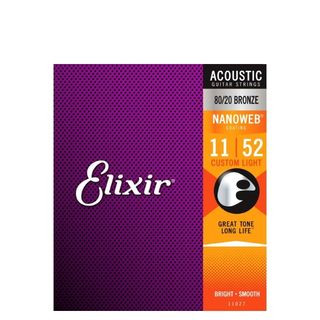 Best acoustic guitar strings: Elixir Nanoweb 80/20 Bronze
Best acoustic guitar strings: Elixir Nanoweb 80/20 Bronze
Best Overall
1. Elixir Nanoweb 80/20 Bronze
Material: 80/20 Bronze
Coating: Nanoweb
Pros:
- Superb sound quality
- Extended lifespan
Cons:
- Higher price point
Elixir Nanoweb 80/20 Bronze strings are my go-to choice for all my gigging acoustic guitars. If longevity is a priority, these strings are hard to beat. Regular wiping after playing further extends their lifespan, making them a reliable choice for frequent performers.
While coated strings can sometimes feel different to players accustomed to uncoated strings, Elixirs come remarkably close to a traditional feel compared to other coated options I’ve tried.
Sonically, they are slightly more subdued than some uncoated strings, but unless you’re in a studio environment with sensitive condenser microphones, this difference is negligible. In fact, their slightly warmer tone can be advantageous for overly bright-sounding acoustic guitars, helping to tame harshness and create a more balanced sound.
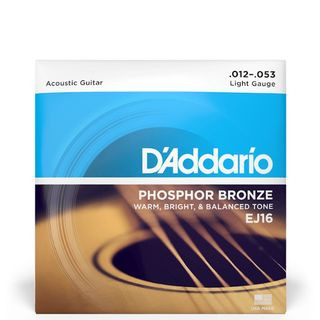 Best acoustic guitar strings: D’Addario EJ16
Best acoustic guitar strings: D’Addario EJ16
Best for Beginners
2. D’Addario EJ16 Acoustic
Material: Phosphor Bronze
Coating: N/A
Pros:
- Excellent value for money
- Wide range of gauges available
Cons:
- Shorter lifespan compared to coated strings
D’Addario EJ16s have been a staple in my string collection for years. In fact, they were the very first set of acoustic strings I ever purchased, back when pop-punk was dominating the airwaves.
I continue to use them because of their exceptional combination of affordability and the extensive range of gauges they offer. This versatility makes them ideal for experimenting with different gauges on various acoustic guitars to optimize playability and tone.
In terms of sound, EJ16s are fantastic, imparting a clear, resonant voice to any acoustic guitar. The primary drawback is their uncoated nature, which means they won’t last as long as coated strings. However, given their affordable price, frequent string changes are less of a financial burden, making them a practical choice for players who prioritize tone and experimentation without breaking the bank.
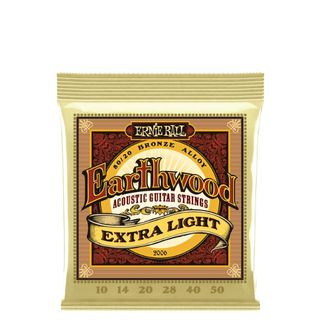 Best acoustic guitar strings: Ernie Ball Earthwood
Best acoustic guitar strings: Ernie Ball Earthwood
Best Budget Option
3. Ernie Ball Earthwood
Material: 80/20 Bronze
Coating: N/A
Pros:
- Extremely affordable
- Well-balanced sound
Cons:
- Can produce noticeable finger squeak
While Ernie Ball is widely celebrated for their electric guitar strings, particularly the iconic Slinky range, their acoustic strings, the Earthwood series, often fly under the radar.
The Ernie Ball Earthwood strings are a remarkably inexpensive option that delivers impressive performance, especially for players on a tight budget. While they aren’t my primary strings, I wholeheartedly recommend them to beginners seeking their first string set or anyone wanting to explore different gauges without significant investment.
The overall sound quality of Earthwood strings is excellent, offering a balanced and pleasant tone. However, I have noticed they tend to produce slightly more finger squeak compared to some other strings on this list. If you’re looking to experiment with various gauges without spending much, Ernie Ball Earthwood strings are an excellent and budget-friendly choice.
 A packet of Martin Retro acoustic guitar strings
A packet of Martin Retro acoustic guitar strings
Best for Fingerpicking
4. Martin Retro
Material: Nickel Copper
Coating: N/A
Pros:
- Warm and mellow tone
- Good value
Cons:
- Not as bright as other strings
While no single string type is exclusively designated for fingerpicking, I find that strings with a slightly less bright and “clanky” character are more conducive to fingerstyle acoustic playing.
The Martin Retro strings perfectly fit this preference, delivering a noticeably warmer tone right out of the packaging compared to standard sets. This distinctive warmth stems from their nickel/copper wrap, which differs from the materials used in other strings listed here, resulting in a more mellow and rounded sound.
I was pleasantly surprised by the longevity of Martin Retro strings, especially considering they are uncoated. While the warmer tone might not appeal to all players, I believe they are an exceptional choice for fingerstyle guitarists seeking a rich, less strident sound that complements the nuances of fingerpicked melodies and harmonies.
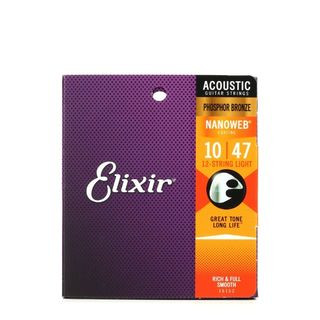 A pack of Elixir Nanoweb 12-string acoustic guitar strings
A pack of Elixir Nanoweb 12-string acoustic guitar strings
Best for 12-String Guitars
5. Elixir 12-String
Material: Phosphor Bronze
Coating: Nanoweb
Pros:
- Quick settling-in period
- Long-lasting performance
Cons:
- Higher cost
Restringing any guitar can be a chore, but doing it on a 12-string acoustic guitar is particularly tedious. While I currently only own one 12-string, I still dread every string change.
My primary reason for favoring Elixir strings on my 12-string is the extended lifespan provided by their coating, significantly reducing the frequency of string changes. While they are more expensive upfront, the time saved and the consistent performance justify the investment.
I also appreciate the sonic characteristics of Elixir strings on a 12-string. The inherent complexity of a 12-string can sometimes lead to excessive overtones, but the coating on Elixir strings subtly mellows the sound, resulting in a more controlled and balanced tone. They also stabilize and settle in tune much faster than uncoated sets, minimizing the frustration of frequent retuning during the initial playing period after restringing.
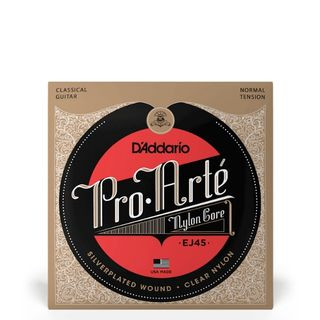 Best acoustic guitar strings: D’Addario EJ45 Pro-Arte
Best acoustic guitar strings: D’Addario EJ45 Pro-Arte
Best Nylon Strings
6. D’Addario EJ45 Pro-Arte
Material: Nylon, Silver-Plated Copper
Coating: N/A
Pros:
- Warm and rich sound
- Balanced tension
Cons:
- Some players prefer higher tension
If you’re restringing a classical guitar, D’Addario EJ45 Pro-Arte nylon guitar strings are, in my opinion, among the best available. Two of my classical guitars are currently strung with these, and they consistently deliver exceptional performance.
D’Addario employs a multi-filament nylon core in these strings, which, simply put, translates to consistent responsiveness and a warm, inviting tone. The treble strings are clear and articulate without being overly bright, making it easier to achieve a balanced sound, especially when playing fingerstyle classical pieces.
I prefer the normal tension set of EJ45s, as it provides an excellent equilibrium between playability and projection. Players seeking greater volume, particularly for purely acoustic performances, might prefer higher tension sets, which D’Addario also offers to cater to different playing preferences and instrument requirements.
FAQs
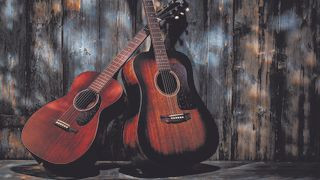 Two acoustic guitars on dark background
Two acoustic guitars on dark background
(Image credit: Future)
Frequently Asked Questions about Acoustic Guitar Strings
What is the best string gauge for acoustic guitars?
String gauge refers to the thickness or diameter of a guitar string. A larger gauge indicates a thicker string. Gauge significantly influences both the playability and the tone of your acoustic guitar, as well as your playing style.
String gauges are measured in thousandths of an inch and are typically denoted by the gauge of the thinnest string, the high E. For example, a “set of 12s” indicates that the high E string has a gauge of 12, measuring 0.012 inches in diameter.
Thicker strings generally produce a fuller, more robust sound. They tend to be louder than thinner strings and exhibit a rounded, bass-rich low end. Their increased durability is a significant advantage. However, thicker gauges also present challenges.
For players still developing finger strength, thicker strings can make fretting more demanding, especially for techniques like string bending and fast runs. Conversely, if you are a heavy-handed strummer or prefer lower tunings, thicker string gauges are often a better choice, providing more resistance and preventing unwanted string buzz.
Lighter gauge strings are easier to fret and bend, and they produce a brighter tone with more pronounced high frequencies. The trade-off is a reduction in deep bass response. For some players, this brighter tone and enhanced playability are preferable.
Consider your acoustic guitar’s body size when choosing string gauge. Smaller-bodied guitars may be complemented by lighter gauge strings, while dreadnought or jumbo-sized acoustics might benefit from thicker strings to drive the larger soundboard. However, these are general guidelines, not rigid rules. Some players prefer heavier strings on smaller guitars for added depth, and vice versa. Experimentation is key to finding your ideal gauge.
Which acoustic strings are best for beginners?
For beginner acoustic guitar players, selecting the right strings is crucial for a comfortable and rewarding learning experience. The ideal strings for beginners strike a balance between playability and tone. Understanding string gauges and their impact on sound and playing feel is essential.
Here are common generic acoustic guitar string gauges. Slight variations may exist between brands, and some brands offer hybrid sets, but this serves as a reliable general guide:
Extra Light: .010 .014 .023 .030 .039 .047
Custom Light: .011 .015 .023 .032 .042 .052
Light: .012 .016 .025 .032 .042 .054
Medium: .013 .017 .026 .035 .045 .056
Heavy: .014 .018 .027 .039 .049 .059
For standard tuning, Extra Light or Custom Light strings are generally recommended for beginners. These are often referred to as “sets of 10s” or “sets of 11s.” They offer a bright, crisp tone and lower string tension, making them easier on developing fingers. As your hand strength and calluses develop, consider experimenting with heavier gauges. However, unless your playing style specifically demands it, there’s no inherent need to use excessively heavy strings.
Note that electric guitar string gauges are named and measured differently. Avoid directly comparing acoustic and electric gauges, as acoustic guitars typically require heavier strings to achieve their optimal sound.
When should I change my acoustic guitar strings?
The frequency of acoustic guitar string changes depends largely on how often you play. However, as a general guideline, restringing your acoustic guitar at least every couple of months is recommended. Regular string changes ensure your instrument consistently sounds and feels its best. Coated strings may offer slightly extended lifespan, but once your strings begin to sound dull or lose their brilliance, it’s time for a fresh set. Listen for a lack of resonance and sustain as indicators that your strings are past their prime.
What are acoustic guitar strings made of?
Acoustic guitar strings are crafted from various materials, each imparting unique tonal characteristics. Common materials include bronze, phosphor bronze, brass, nickel, silk, and steel.
Bronze strings are known for their bright, resonant sound, characterized by bell-like clarity and a wide, treble-focused frequency response. Phosphor bronze strings, as the name suggests, incorporate phosphor into the bronze alloy. This addition slows down oxidation, extending string life. Phosphor bronze strings typically sound slightly warmer and darker than pure bronze strings.
Brass strings deliver a bright, jangly tone with pronounced high-end frequencies. Nickel strings offer a warmer, more vintage-sounding tone, making them a popular choice for players seeking a classic acoustic sound. Monel, a nickel-based alloy, is also favored by many guitarists for its ability to enhance the natural resonance of tonewoods.
Are nylon guitar strings easier to play?
In short, yes, nylon guitar strings are generally easier to play than steel strings. Nylon strings, used on classical guitars, are categorized by tension levels, typically high or low. High-tension nylon strings offer a firmer feel, while low-tension strings are even easier to play. However, even high-tension nylon strings exert significantly less tension on the guitar neck and fingers than steel or bronze strings. This lower tension is a primary reason why many beginners start learning on nylon-string classical guitars.
Classical guitar string sets typically consist of three treble strings made of clear or rectified nylon and three bass strings made of bronze or silver-plated copper wire wrapped around a multi-filament nylon core. Nylon strings are specifically designed for classical guitars and should never be used on steel-string acoustic guitars. The significant difference in tension could cause serious damage to a classical guitar if strung with steel strings.
How We Choose the Best Acoustic Guitar Strings
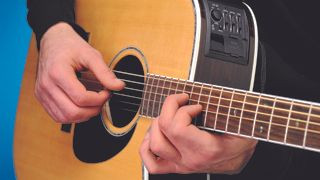 Man plays chord on acoustic guitar
Man plays chord on acoustic guitar
(Image credit: Future)
My approach to testing acoustic guitar strings involves rigorous evaluation over an extended period to ensure they meet the diverse needs of acoustic guitarists.
The initial step is to string up an acoustic guitar with a fresh set of strings and monitor their settling-in period. This test assesses how quickly the strings stretch and stabilize in tune. The best string sets will achieve tuning stability within a few hours, requiring only minor adjustments after initial playing.
Next, I evaluate the string feel and playability under my fingers. I look for strings that are smooth and free of imperfections that could hinder playing comfort or speed. For coated strings, the ideal is a coating that is imperceptible to the touch. While coated strings invariably feel slightly different from uncoated strings, advancements in coating technology have minimized this difference in recent years.
Corrosion resistance is a critical factor in string longevity. To assess usable lifespan, I leave strings on the guitar for an extended period, noting when they begin to show signs of discoloration, tarnish, or sonic degradation.
Throughout the testing process, I meticulously evaluate the string’s sound quality. Across various playing styles, musical genres, and acoustic environments, I listen critically to the string’s tonal response and how it evolves over time.
My extensive experience playing and listening to numerous acoustic guitars and string sets provides a solid foundation for my evaluations. While sonic assessments are inherently subjective, I strive to provide balanced and objective observations, acknowledging that individual tonal preferences vary among musicians.
Read more about how we test music-making gear and services at MusicRadar.
